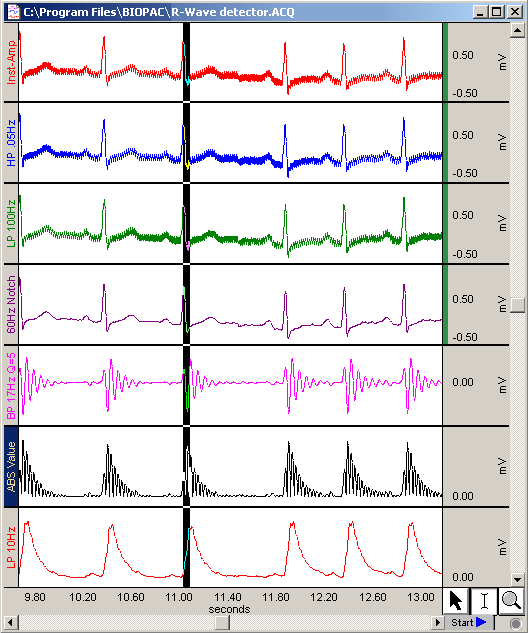H26 BME Breadboard II

BSL PRO Signal Processing Labs are a series of lessons that explain how to create and test the types of electronic circuits used in Biomedical Engineering.
Concepts introduced include the basics of amplifiers (with special emphasis on the biopotentials), Gain, Common-mode rejection (CMR), Electrode polarization, Frequency response, Input impedance, Signal noise and drift, Filters, and ECG circuit requirements.
The Signal Processing Labs use the BIOPAC SS39L Signal Processing Breadboard with Interface Cables and Electrode Interface. The human body can be studied by viewing the potential difference (Voltage) between strategically placed surface electrodes. In order to view and record the potential difference between surface electrodes, electronic circuits are used. Electrode leads, which are essentially wires, connect the electrodes to the circuit. Most signals from physiological activity have small amplitudes and must be amplified and processed before they can be viewed in a meaningful way.
Experimental Objectives
- Square Wave Oscillator
- Instrumentation Amplifier
- Active Filter: High Pass
- Active Gain Block & Low Pass
- Notch Filter for 50/60 Hz Rejection
- QRS Detection: Band Pass Filter
- QRS Detection: Absolute Value Circuit
- QRS Detection: Low Pass Filter and Overall System Test
Tasks Performed by the Student
- Students create and test circuits.
See BME white papers and resources below.
Videos
BSL BME Instrumentation Amplifier
BSL BME Notch Filter
BSL BME Band Pass Filter
BSL BME Absolute Value Circuit
BSL BME QRS Detection
Biopac Student Lab Student Download
Student Prep & Distance Learning
Click the link(s) below for sample data and/or lesson procedure video(s), BSL PRO Lesson procedures (PDF) for human lessons*, and graph template files (*.gtl) for BSL PRO Lessons. If more than one .gtl is available, download the .gtl with the _suffix to match BSL version and hardware.
- h25-h26_bme_labs_preview.pdf
- ecgsys.gtl
- ecgsys_bsl4.gtl
- Click here to request the BME lessons PDF - breadboard engineering lessons are available by request only
- Physiological Signal Processing Lab (white paper)
- Students as Signal Sources (white paper)
- Inquiry-based BME Signals (white paper)
- The Whitaker Foundation (supporting research and education in biomedical engineering 1975-2006)
Lesson Hardware
This lesson requires a Biopac Student Lab (BSL) System and the following hardware. If your BSL System does not include all hardware items, expand your system by selecting required items below. For more details, review the Lesson: L# BSL Lessons - see the Lab Manual or launch BSL; A# and H# BSL PRO Lessons, click the PDF link above to review full setup, recording, and analysis procedures.
Stay Connected